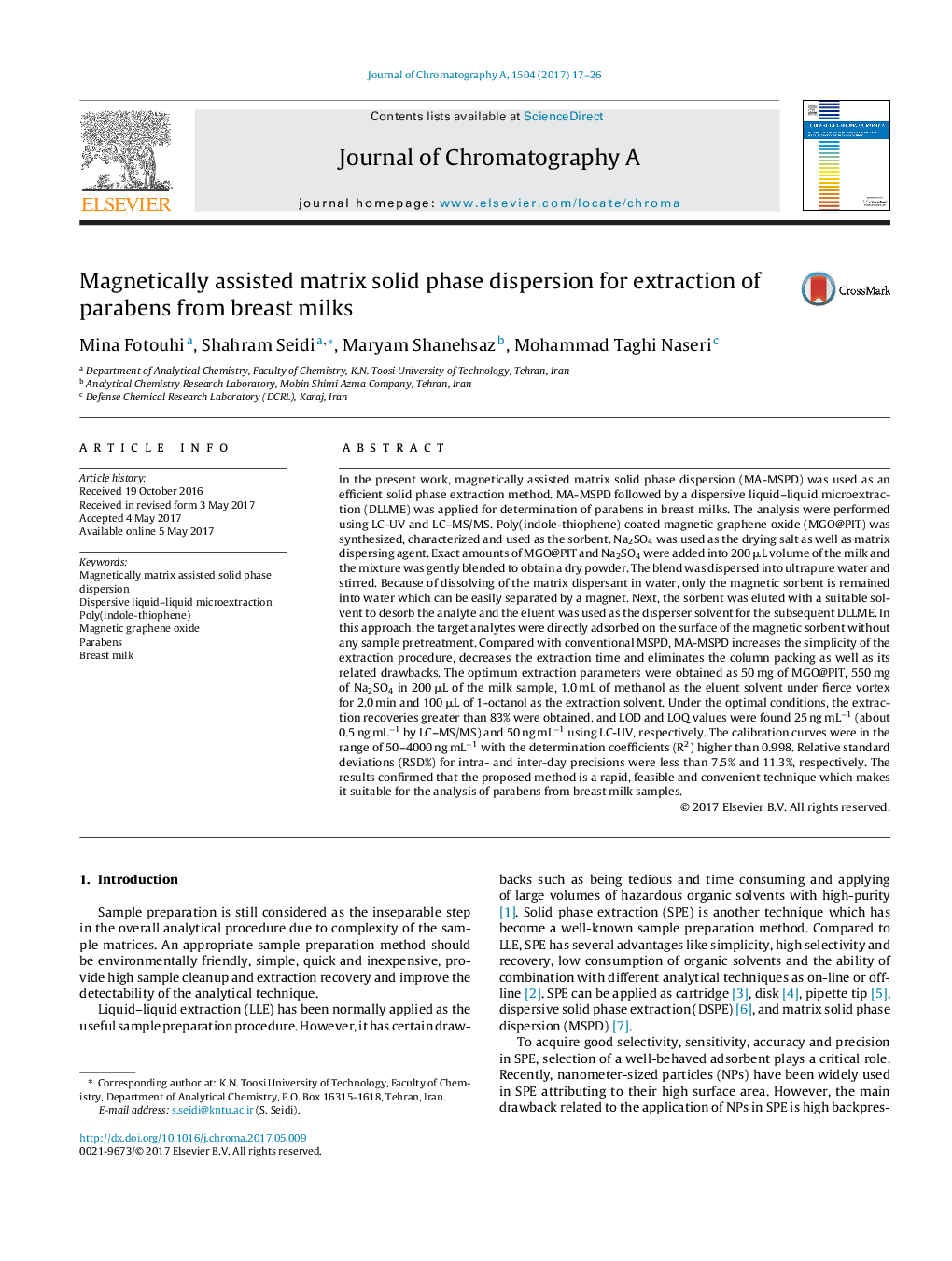| کد مقاله | کد نشریه | سال انتشار | مقاله انگلیسی | نسخه تمام متن |
|---|---|---|---|---|
| 5135192 | 1493422 | 2017 | 10 صفحه PDF | دانلود رایگان |
عنوان انگلیسی مقاله ISI
Magnetically assisted matrix solid phase dispersion for extraction of parabens from breast milks
دانلود مقاله + سفارش ترجمه
دانلود مقاله ISI انگلیسی
رایگان برای ایرانیان
کلمات کلیدی
موضوعات مرتبط
مهندسی و علوم پایه
شیمی
شیمی آنالیزی یا شیمی تجزیه
پیش نمایش صفحه اول مقاله

چکیده انگلیسی
In the present work, magnetically assisted matrix solid phase dispersion (MA-MSPD) was used as an efficient solid phase extraction method. MA-MSPD followed by a dispersive liquid-liquid microextraction (DLLME) was applied for determination of parabens in breast milks. The analysis were performed using LC-UV and LC-MS/MS. Poly(indole-thiophene) coated magnetic graphene oxide (MGO@PIT) was synthesized, characterized and used as the sorbent. Na2SO4 was used as the drying salt as well as matrix dispersing agent. Exact amounts of MGO@PIT and Na2SO4 were added into 200 μL volume of the milk and the mixture was gently blended to obtain a dry powder. The blend was dispersed into ultrapure water and stirred. Because of dissolving of the matrix dispersant in water, only the magnetic sorbent is remained into water which can be easily separated by a magnet. Next, the sorbent was eluted with a suitable solvent to desorb the analyte and the eluent was used as the disperser solvent for the subsequent DLLME. In this approach, the target analytes were directly adsorbed on the surface of the magnetic sorbent without any sample pretreatment. Compared with conventional MSPD, MA-MSPD increases the simplicity of the extraction procedure, decreases the extraction time and eliminates the column packing as well as its related drawbacks. The optimum extraction parameters were obtained as 50 mg of MGO@PIT, 550 mg of Na2SO4 in 200 μL of the milk sample, 1.0 mL of methanol as the eluent solvent under fierce vortex for 2.0 min and 100 μL of 1-octanol as the extraction solvent. Under the optimal conditions, the extraction recoveries greater than 83% were obtained, and LOD and LOQ values were found 25 ng mLâ1 (about 0.5 ng mLâ1 by LC-MS/MS) and 50 ng mLâ1 using LC-UV, respectively. The calibration curves were in the range of 50-4000 ng mLâ1 with the determination coefficients (R2) higher than 0.998. Relative standard deviations (RSD%) for intra- and inter-day precisions were less than 7.5% and 11.3%, respectively. The results confirmed that the proposed method is a rapid, feasible and convenient technique which makes it suitable for the analysis of parabens from breast milk samples.
ناشر
Database: Elsevier - ScienceDirect (ساینس دایرکت)
Journal: Journal of Chromatography A - Volume 1504, 30 June 2017, Pages 17-26
Journal: Journal of Chromatography A - Volume 1504, 30 June 2017, Pages 17-26
نویسندگان
Mina Fotouhi, Shahram Seidi, Maryam Shanehsaz, Mohammad Taghi Naseri,